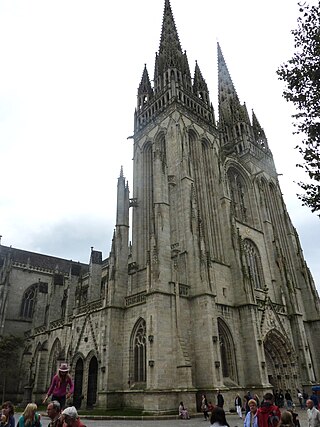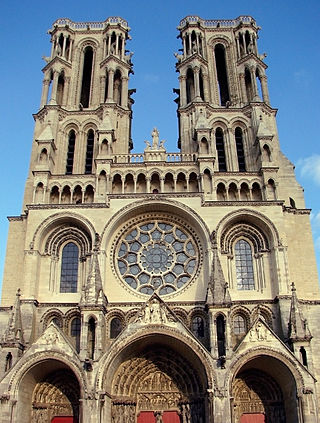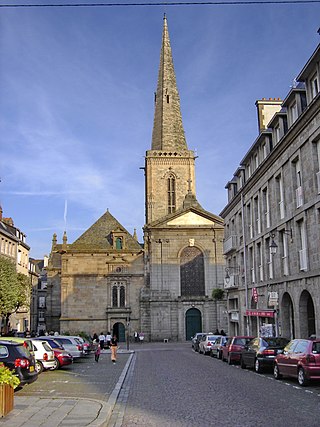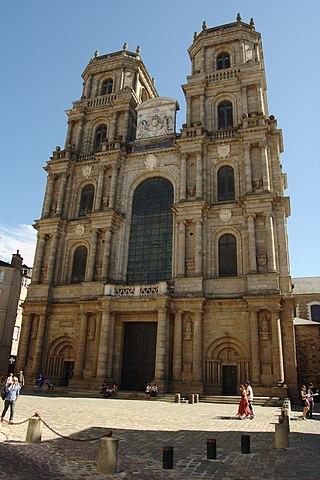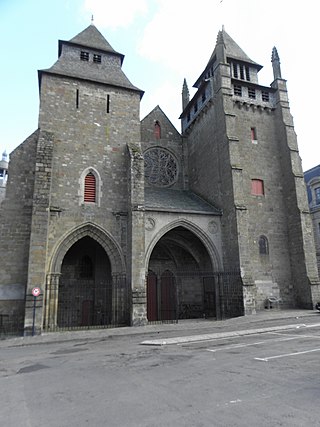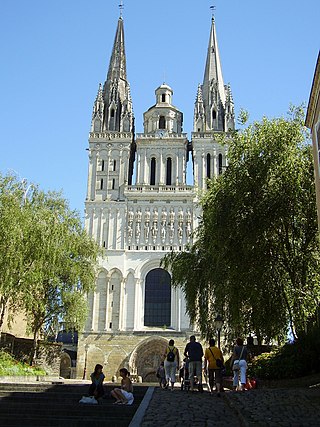History
The Life of St. Samson, which cannot be of earlier date than the seventh century, mentions the foundation of the monastery of Dol by St. Samson. He was doubtless already a bishop when he came from Great Britain to Armorica, and it is he perhaps who assisted at the Council of Paris between 561 and 567. But in the biography there is nothing to prove that he founded the See of Dol or that he was its first bishop. [2]
In the twelfth century, to support its claim against the Metropolitan of Tours, the Church of Dol produced the names of a long list of archbishops: St. Samson, St. Magloire, St. Budoc, St. Génevée, St. Restoald, St. Armel, St. Jumael, St. Turian. Louis Duchesne discounted and doubted this list. He was of the opinion that the abbey of Dol may have had at its head from time to time abbots with episcopal jurisdiction, but that Dol was not the seat of a diocese. [2]
Under Charlemagne and Louis the Pious, the Vicariate of Dol and the monastery of St. Méen were still included in the Diocese of Aleth; so that the first Bishop of Dol was Festianus (Festgen) mentioned for the first time between 851 and 857, and installed by King Nomenoë. Among the bishops of Dol are: [2]
- Baudri (1107–30), author of a poem on the conquest of England by William the Conqueror
- Alain de Coëtivy (1456–74), as legate of Callistus III, brought Charles VII to assist the Greeks against the Turks who were besieging Constantinople
- Urban René de Hercé (1767–95), emigrated to England during the Revolution, but accompanied to Brittany the royalist troops who attempted to land at Quiberon. He was arrested with his brother, and shot at Vannes, 3 July 1795. [2]
There was a struggle from the ninth to the eleventh century to free the Church of Brittany from the Metropolitan of Tours. From a comparison made by Duchesne between the Life of St. Conwoïon , the Indiculus de episcoporum Britonum depositione, and an almost completely restored letter of Pope Leo IV, it would appear that shortly before 850, Nomenoë wishing to be anointed king, and finding opposition among the prelates of Brittany, sought to get rid of them by charging them with simony. Their only fault was perhaps that they demanded eulogia from their priests when the latter came to synods. After listening to a deputation of Breton bishops and to St. Conwoïon, founder of the Abbey of St-Sauveur at Redon, who had been sent to Rome by Nomenoë, Leo IV declared that the charge of simony must be adjudicated by a competent tribunal of twelve bishops, and must be attested by seventy-two witnesses, thereby disputing Nomenoë's claim to a right to depose bishops. But Nomenoë did depose, and in a brutal manner, the four bishops of Vannes, Aleth, Quimper, and St. Pol de Léon, and made seven dioceses out of their four. One of the new dioceses had its seat in the abbey of Dol and became straightway an archdiocese. The remaining two were in the monasteries of St. Brieuc and Pabu-Tutual (Tréguier). [2]
At the end of 850 or beginning of 851 the bishops of the four provinces of Tours, Sens, Reims, and Rouen, wrote a letter of reprimand to Nomenoë and threatened him with excommunication. He paid no heed to them and died 7 March, 851. Salomon, Nomenoë's second successor, requested Pope Benedict IV in vain to regularize the situation of the Breton hierarchy. In the name of the Council of Savonnières (859) the seven metropolitans of the three kingdoms of Charles the Bald, of Lothair II, and of Charles of Provence, wrote to the Bishop of Rennes and to the bishops occupying the new Sees of Dol, St. Brieuc, and Tréguier, reproaching them with lack of obedience to the Metropolitan of Tours. This letter was not sent to the Bishops of Vannes, Quimper, Aleth, and St. Pol de Léon who wrongly occupied the sees of the legitimate bishops illegally deposed by Nomenoë. It achieved nothing. [2]
In 862 Salomon dealt directly with Pope Nicholas I, and at first tried to mislead the pope by means of false allegations and forgeries; then he restored Felix of Quimper and Liberalis of Léon to their sees, but still kept Susannus of Vannes and Salocon of Aleth in exile. Nicholas I died in 867. Pope Adrian II (867-72) and Pope John VIII (872-82) continued to uphold the rights of the Metropolitan of Tours. Then came the deaths of Salomon and of Susannus, and a conciliatory mood developed. [2]
There was no formal act on the part of the Holy See recognizing Dol as a new metropolitan church; it never had control over Rennes or Nantes, and it was mainly over the new Sees of St. Brieuc and Tréguier that it exercised ascendancy. Finally in May, 1199, Pope Innocent III restored the old order of things, and subordinated anew all Brittany to Tours but did not interfere with the diocesan boundaries set up by Nomenoë, and they remained in force until the Revolution. The Bishop of Dol retained until 1789 the insignia of an archbishop, but without an archbishop's privileges. [2]


